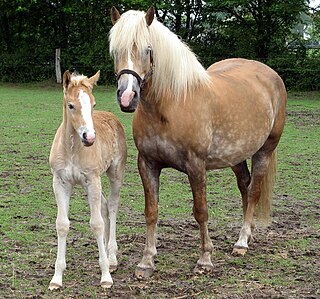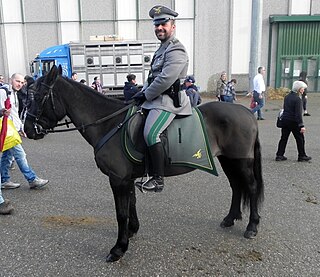Related Research Articles

The Haflinger, also known as the Avelignese, is a breed of horse developed in Austria and northern Italy during the late 19th century. Haflinger horses are relatively small, are always chestnut with flaxen mane and tail, have distinctive gaits described as energetic but smooth, and are well-muscled yet elegant. The breed traces its ancestry to the Middle Ages; several theories for its origin exist. Haflingers, developed for use in mountainous terrain, are known for their hardiness. Their current conformation and appearance are the result of infusions of bloodlines from Arabian and various European breeds into the original native Tyrolean ponies. The foundation sire, 249 Folie, was born in 1874; by 1904, the first breeders' cooperative was formed. All Haflingers can trace their lineage back to Folie through one of seven bloodlines. World Wars I and II, as well as the Great Depression, had a detrimental effect on the breed, and lower-quality animals were used at times to save the breed from extinction. During World War II, breeders focused on horses that were shorter and more draft-like, favored by the military for use as packhorses. The emphasis after the war shifted toward animals of increased refinement and height.

The Noriker horse, also called the Norico-Pinzgauer and historically known as the Pinzgauer horse, is a moderately heavy Austrian draught horse breed. The Noriker is considered indigenous to the central Alpine region of Europe, and is believed to have originated around the highest mountain of Austria, the Grossglockner. This region was once known as the Roman province of Noricum. At the end of the 19th century the original name Pinzgauer horse was changed to Noriker horse, due in part to the Romanophile attitude in this time.

The Pustertaler Sprinzen, also called Pustertaler or Pustertaler Schecken, is a rare breed of cattle from the Puster Valley in the autonomous province of Bolzano, now in north-eastern Italy. Genetic research carried out in 2001 showed the Barà breed of the province of Turin to be closely similar to the Pustertaler; the two populations have since 2002 been treated and registered as a single breed. It is one of the sixteen minor Italian cattle breeds of limited diffusion recognised and protected by the Ministero delle Politiche Agricole Alimentari e Forestali, the Italian ministry of agriculture.

The Piedmontese is a breed of domestic cattle that originated in the region of Piedmont, in north-west Italy. The calves are born fawn coloured, and turn grey-white as they mature. Piedmontese cattle carry a unique gene mutation identified as an inactive myostatin allele that causes hypertrophic muscle growth, or double muscling. Purebred Piedmontese cattle are homozygous, meaning they have two identical alleles present for this unique gene. They have garnered attention from breeders of beef cattle in other parts of the world, including North and South America. A small group of select Piedmontese bulls and cows were imported into Canada in the late 1970s, and into the United States in the early 1980s, and were used as the foundation breeding stock to develop a new breed of beef cattle known as North American Piedmontese cattle.

The Italian Heavy Draft, or Rapid Heavy Draft, is a breed of draft horse from Italy. The full Italian name of the breed is Cavallo Agricolo Italiano da Tiro Pesante Rapido, "Italian Rapid Heavy Draft Farm Horse", and the abbreviation TPR ) is often used.

The Sardinian Anglo-Arab or Anglo-Arabo Sardo is an Italian breed of riding horse from the Mediterranean island of Sardinia. It derives from cross-breeding of local mares with stallions of Arab, Anglo-Arab and Thoroughbred stock. Breeding began in 1874; the breed was officially recognised in 1967.

The Bardigiano is a traditional Italian breed of small horse. It originates in the region of Emilia Romagna and takes its name from the town of Bardi, in the province of Parma. It is strongly associated with Bardi, the Valle del Ceno and the Val di Taro, and surrounding areas of the Tusco-Emilian Apennines of Parma.

The Neapolitan Horse, Italian: (Cavallo) Napoletano, Neapolitano or Napolitano, is a horse breed that originated in the plains between Naples and Caserta, in the Campania region of Italy, but which may have been bred throughout the Kingdom of Naples. The Neapolitan horse was frequently mentioned in literature from the 16th to the 19th centuries, and is noted for its quality. Corte wrote in 1562: "in Italy the horses of the Kingdom of Naples are greatly esteemed; [there] many fine coursers are born ... suitable for use in war and in the manège and for every service that the rider may require". The decline of the breed was noted in the early 20th century by Mascheroni (1903) and Fogliata (1908). Some sources state that by 1950, the original Neapolitan horse was deemed extinct, but its lines were incorporated into other breeds, most notably the Lipizzaner. An attempt to recreate this breed resulted in the modern breed called Napolitano.

The Tolfetano or Cavallo Tolfetano is a breed of horse from the northern part of the Lazio region of Italy. It is indigenous to the Monti della Tolfa range of hills which lie within the Maremma Laziale, and which give the breed its name. The harsh terrain and limited resources of the area are thought to have contributed to the resistant and frugal nature of the breed.

The Italian Landrace is an Italian breed of domestic pig. It derives from the Danish Landrace breed developed in Denmark at the end of the nineteenth century. Stock was imported into Italy after the Second World War. The breed has been selected principally for suitability for the production of prosciutto crudo. It is, after the Large White Italiana, the second-most numerous pig breed in Italy. The breed standard is issued by the Ministero delle Politiche Agricole Alimentari e Forestali, the Italian ministry of agriculture and forestry; the herdbook is kept by the Associazione Nazionale Allevatori Suini, the national pig-breeders' association.

The Cavallo Romano della Maremma Laziale, or "Roman horse of the part of the Maremma that is in Lazio", is a horse breed native to the Lazio region of Italy. An ancient breed, it was officially recognised only in 2010; it is now one of the fifteen indigenous horse "breeds of limited distribution" listed by the AIA, the Italian breeders' association. The Lazio region has assigned it the conservation status "at risk of erosion". The population numbers about 800, of which most are in the comune of Monte Romano in the province of Viterbo; a herd of approximately 200 is at Ponzano Romano in the province of Rome, and others are in the province of Rieti.

The Esperia Pony is a breed of pony originating in the area of the Aurunci Mountains and Ausoni Mountains near Esperia in the province of Frosinone, in the Lazio region of Italy. It is one of the fifteen indigenous horse "breeds of limited distribution" recognised by the AIA, the Italian breeders' association. It is the only Italian breed to be officially denominated a pony.

The Monterufolino or Cavallino di Monterufoli is a breed of small horse originating in the province of Pisa, in the Tuscany region of Italy. It is one of the fifteen indigenous horse "breeds of limited distribution" recognised by the AIA, the Italian breeders' association. It takes its name from a former farm estate, the "Tenuta di Monterufoli", now broken up, which covered some 4000 Ha in the comuni of Pomarance, Montecatini Val di Cecina and Monteverdi Marettimo.

The Catria or Cavallo del Catria is an Italian breed of horse. It is named for the massif of Monte Catria in the Marche region of Italy, where it is thought to have originated, and is distributed also in parts of the provinces of Ancona, Perugia and Pesaro. It is one of the fifteen indigenous horse "breeds of limited distribution" recognised by the AIA, the Italian breeders' association.
The Pentro or Cavallo Pentro is an endangered Italian breed of small rustic horse. It originates in the upper valley of the Volturno in the southern Italian region of Molise, close to its borders with Abruzzo, Campania and Lazio, and takes its name from the ancient Samnite tribe of the Pentri, who lived in that area. The population is concentrated in the comune of Montenero Val Cocchiara in the province of Isernia. It is one of the fifteen indigenous horse "breeds of limited distribution" recognised by the AIA, the Italian breeders' association.
The Sarcidano, Italian: Cavallo del Sarcidano, is a rare Italian breed of semi-feral horse originating from the Altopiano del Sarcidano in the comune of Laconi, in Oristano Province of the Mediterranean island of Sardinia. It is one of the fifteen indigenous horse "breeds of limited distribution" recognised by the AIA, the Italian breeders' association.
The Samolaco is a rare breed of horse originating from the Valchiavenna and Valtellina, in Lombardy, northern Italy. It takes its name from the town of Samolaco, near Chiavenna in the province of Sondrio. Gravely endangered, it is not among the fifteen indigenous horse "breeds of limited distribution" recognised by the AIA, the Italian breeders' association. The population is listed in DAD-IS as over 12 in 1994, and under 100 in 1998; one further example of the breed may have been identified during a television broadcast.
The Robusta Maculata is a modern Italian dual-purpose breed of chicken. It originates in the city of Rovigo in the Veneto region of north-eastern Italy, where it was created between 1959 and 1965 by cross-breeding Buff Orpingtons with the commercial strain known in Italy as "White America".

The Martina Franca donkey, Italian: Asino di Martina Franca, is a breed of donkey from Puglia in southern Italy. It is the largest Italian donkey breed, and was famous for its qualities in the production of mules. It is particularly associated with the comune of Martina Franca from which it takes its name, but the area of origin also includes Alberobello, Ceglie Messapica, Locorotondo, Massafra, Mottola and Noci, in the provinces of Bari, Brindisi and Taranto. It is still raised mainly in Puglia, but there are also populations in Abruzzo, Lazio, Lombardy and Umbria. It is one of the eight autochthonous donkey breeds of limited distribution recognised by the Ministero delle Politiche Agricole Alimentari e Forestali, the Italian ministry of agriculture and forestry.

The Rendena is a breed of cattle from the Trentino, in north-eastern Italy, now raised principally in the provinces of Padova, Trento, Verona and Vicenza. It is particularly suited to transhumant management; almost all the stock in the Trentino spends the summer months on the mountain pastures of the Val Rendena, and more than half of that in the Veneto summers on the Altopiano di Asiago.
References
- 1 2 "Registro Anagrafico delle razze equine ed asinine a limitata diffusione" [Register of Equine and Donkey Breeds with limited distribution](PDF). Associzione Italiana Allevatori [Italian Breeders Association] (in Italian). p. 12.